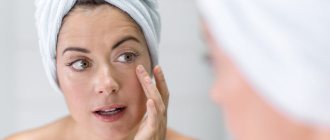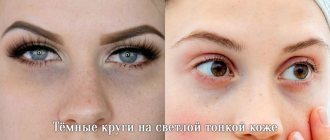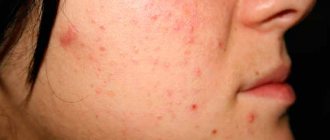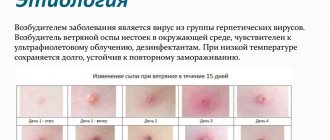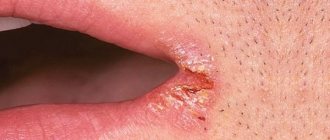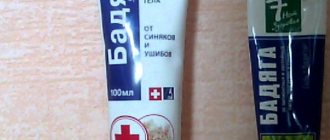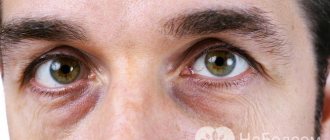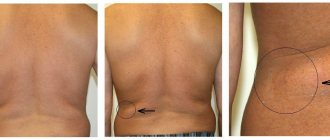Causes and provoking factors
Sensitive eyelid skin reacts negatively to any negative external influence. The epidermis turns red, cracks and peeling appear. Also, such symptoms can signal a malfunction of the internal organs. Most often, problems with the skin around the eyes are caused by the following factors:
- Allergic reaction;
- Use of low quality cosmetics;
- Eyelash mite causing demodicosis;
- Inflammatory lesion of the epidermis resulting from exposure to damaging factors;
- Failure to comply with personal hygiene rules;
- Fatigue of the organ of vision;
- Exposure to sunlight;
- Weathering;
- Spending a long time in front of a computer monitor;
- Lack of vitamins;
- Infectious disease;
- Dry eye syndrome;
- Fungus.
| Several factors can simultaneously cause peeling of the eyelid. To stop the disease, it is necessary to identify them all and eliminate them with the help of well-chosen therapy. |
Allergy
One of the most common reasons causing the development of anomalies. When a person comes into contact with an allergen, the eyes become very watery, and accordingly the skin becomes irritated and begins to peel off. The longer the body is exposed to the “pest”, the stronger the unpleasant symptoms.
Most often, a negative reaction occurs upon contact with the following irritants:
- Plant pollen;
- Animal wool;
- Cosmetical tools;
- Products;
- Dust;
- Harmful fumes from household chemicals, etc.
To get rid of an allergic reaction, you must stop contact with the irritant.
Demodicosis
This ophthalmic disease is caused by eyelash mites. Most often it appears in autumn and spring. The cause of the damage is a weakened immune system; pensioners are also at risk. Mites get under the skin of the eyelids and begin to feed on hair follicles and can affect the sebaceous glands. The first symptom of the disease is loss of eyelashes and inflammation of the eyes, increased lacrimation and peeling of the skin under the eyelids.
Self-medication should not be practiced under any circumstances; any medications should be prescribed by a doctor after a preliminary examination and a series of examinations.
You will learn how to protect yourself from demodicosis from the video.
Fungus
Failure to comply with basic hygiene rules and the use of other people's cosmetics leads to a person contracting a harmful fungus. In this case, you need to prepare for long-term treatment, since it is impossible to get rid of the “pest” in a couple of days.
As a result of a fungal infection, chronic mycosis can develop, affecting the hair and nails. The risk group includes people with weak immune systems. Often the fungus “joins” other pathologies, such as diabetes or oncology. Return to contents
Infectious diseases
If the eyelid is peeling, the reason may be hidden in the development of such ailments as:
- Conjunctivitis;
- ARVI;
- Problems with the gastrointestinal tract;
- Trachoma;
- Herpes;
- Keratitis.
Bacterial blepharitis often affects the delicate skin around the eyes. The disease can affect the cornea and conjunctiva. To treat the disease, ointments are used that contain gentamicin or erythromycin.
| Seborrheic dermatitis is harmful to the skin. Its main signs are swelling of the eyelids, the appearance of small scales between the eyelashes that connect to the epidermis. In appearance they resemble dandruff. |
Lack of vitamins
Peeling of the skin provokes a lack of vitamins A, D and E. The causes of vitamin deficiency include:
- Unbalanced diet;
- The presence of an illness accompanied by problems with the absorption of beneficial microelements from the intestines;
- Lack of solar radiation;
- Taking medications containing vitamin antagonist substances.
To eliminate unpleasant symptoms, review your menu and lifestyle.
Inappropriate cosmetics and improper care
These factors often cause the development of anomalies. To avoid skin flaking and redness, follow these rules:
- Do not use cosmetics containing abrasive particles;
- Do not wipe the area around the eyes with toners that contain alcohol;
- Never apply expired cosmetics to your skin;
- Select products according to your age;
- Store cosmetics correctly;
- Wash your hands before applying makeup;
- Make sure that all instruments that come into contact with the eyelid skin are clean.
When caring for the area around the eyes, the following is prohibited:
- Rub cosmetics intensively;
- Leave them overnight;
- Apply masks more often than prescribed in the instructions;
- Use toilet soap to remove cosmetics.
If you experience itching or burning after applying skin care products, wash them off immediately. Rinse your eyes with clean water and take Diazolin or Suprastin.
Herpes and adenovirus
The first disease is accompanied by the appearance of small blisters; with complications, ulcers form in their place. Adenovirus affects both eyes simultaneously and is accompanied by pathologies of the respiratory system.
Acyclovir is used to treat herpes. For the treatment of adenoviral conjunctivitis, warming lotions and eye drops from the group of corticosteroids are used.
Treatment for peeling around the eyes
It is possible to determine what causes peeling of the skin around the eyes and begin treatment only after examination by a doctor and diagnosis. If you do not adhere to this rule, then instead of healing and solving the problem, the skin will begin to peel off more, and new complications will appear. What is suitable for one type of disease cannot be used to treat another. Antibiotics used during a staph infection can trigger allergies.
There are folk methods used for skin care, relieving inflammation, dryness, swelling, redness:
- chamomile decoction;
- decoction of string;
- calendula decoction;
- aloe juice;
- egg yolk;
- vegetable oil – sea buckthorn, flaxseed, pumpkin, sesame or olive.
The disadvantage of these products is that they help if the skin peels slightly, the manifestations are temporary. It is useless to use them in the fight against bacterial infections, skin mites, and allergic irritations. Each disease has its own treatment strategy:
- Demodex is treated with sulfur ointment, which cannot damage the eyes, unlike sprays.
- Infectious diseases - antibiotic drugs.
- Allergy – elimination of the irritant, antihistamines.
- Intestinal diseases - taking probiotics, increasing the daily volume of fluid consumed.
- Hyperemia - by moisturizing the skin, prescribing medications that help normalize blood circulation.
Associated symptoms
Peeling of the skin around the eyelids is accompanied by additional symptoms. Some of them are very specific and help to easily identify the cause that triggered the development of the anomaly.
Typical accompanying symptoms:
- Unbearable itching;
- Redness of the epidermis around the eyes;
- Swelling of the eyelids;
- Intolerance to bright light;
- Increased tear production;
- Pain in the eyes;
- Eyelashes break and fall out;
- Redness of the sclera is observed.
| Discharge of pus may signal the development of conjunctivitis; in this case, before starting treatment, it is necessary to establish its type (allergic, bacterial, etc.). |
If the skin under your eyes peels, you should immediately consult a doctor. Unbearable itching and redness cause discomfort, and the damaged epidermis becomes very thin, which can lead to serious complications. Medical attention is required if unpleasant symptoms persist for three days. Return to contents
Peeling skin on eyelids
Peeling of the eyelids in the lower and upper parts near the eyes often occurs in women who do not take care of the hygiene of the skin around the eyes before bed. Dermatologists advise using a special makeup remover and moisturizer that softens the skin and removes shadow and mascara particles without damaging the eyes. If this is the reason, then the irritation quickly passes. In other cases, when, in addition to slight peeling, severe itching and swelling appears, you should seek help from a clinic.
Diagnostics
Initially, the ophthalmologist conducts a visual examination of the patient, asking him in detail about the symptoms accompanying the course of the disease and illnesses suffered in the recent past.
To make an accurate diagnosis, a blood test is performed, eye secretions and tear fluid are taken for examination. To visually analyze the condition of the organ of vision, the doctor uses a slit lamp. To detect eyelash mites, four eyelashes are taken from the upper and lower eyelids for laboratory testing.
Products and simple recipes to combat dry eyelids
With the problem of dryness, simple recipes can help you, as well as products that are almost always on hand.
— Quail eggs (have beneficial properties), you need to use the yolks, they will perfectly help in nourishing and moisturizing the skin of the eyelids. — Sour cream with a high percentage of fat content, sour cream can be replaced with yogurt, yogurt should be without additives so as not to cause allergies. — Honey – the beneficial properties of honey can be listed for a long time, so it is also an assistant in the fight for healthy eyelid skin. — Olive oil (vegetable, peach, jojoba), banana and cucumber are also suitable for softening and nourishing. — Aloe is an excellent healer, as well as an assistant in the fight for beautiful and healthy eyelid skin. — Cosmetologists recommend after 36 years of age to nourish the skin with grape seed oil for prevention. — Preference in choosing a cream or care product should be given to products with collagen and hyaluronic acid. - Last but not least are cosmetics that will help eliminate dry eyelids. It is necessary to use micellar water or hydrophilic oil, which in turn has a gentle composition, removes dirt, and does not remove moisture from the skin at all.
Treatment with drugs
Therapy is selected for each patient individually after identifying the factor that triggered the development of the disease. It is important to treat not the manifestation of the disease, but its source. Otherwise, any measures will not bring results.
Most often, medications are the first to hit the target. The doctor may prescribe the following medications:
- Antibiotics. The most commonly prescribed eye drops are Okomistin, Albucid and Tsipromed. For damage to the mucous membrane, tetracycline ointment is used;
- Antiallergic and antihistamine medications. Helps get rid of itching and relieve swelling. This could be Claritin, Loratidine, or hormonal ointments that contain hydrocortisone;
- Antiseptic drugs. Block the spread of pathogenic microorganisms. Use the most gentle means, such as “Vitabakt” or a solution of boric acid;
- To combat the fungus, Levorin or Nystatin is prescribed;
- Antiviral drugs. These include “Anaferon”, “Solcoseryl”;
- If the cause of peeling lies in inflammation, then Sofradex or Maxitrol eye drops will help;
- To relieve visual fatigue, doctors recommend taking Visine.
To strengthen the immune system and increase the body's resistance to negative factors, take a course of Vitrum Vision or Complivit Oftalmo vitamins.
| Often, to get rid of unpleasant symptoms, doctors prescribe topical medications (ointments and drops). They affect the source of the disease and almost never enter the circulatory system. If you need to use several types of drops, use them with a break of fifteen minutes. |
Treatment of redness and peeling of the skin of the eyelids, depending on the cause
Treatment of redness and peeling of the skin on the eyelids should be comprehensive and aimed at eliminating the etiological factor, relieving the symptoms of the disease, preventing relapses and recurrences.
What to do if peeling is caused by allergies
After identifying and eliminating the cause of the allergy, the doctor prescribes antihistamines depending on the age and individual characteristics of the patient’s body.
For short-term use, first generation drugs are most often used (Suprastin, Diphenhydramine, Fenkarol, Tavegil, Diazolin). They have a quick and strong effect, but at the same time have a sedative effect.
Second generation antihistamines (Claridol, Clarotadine, Kestin, Lomilan, Claritin, Zyrtec) do not inhibit mental and physical activity and are not addictive.
Their duration of action is 24 hours, and the therapeutic effect is observed within 5-7 days after discontinuation of use.
Attention! These drugs are contraindicated in patients with disorders of the cardiovascular system. Third generation antiallergic drugs (Telfast, Gismanal, Trexil) have a minimal number of contraindications, but are expensive
Third generation antiallergic drugs (Telfast, Gismanal, Trexil) have a minimal number of contraindications, but are expensive.
In addition to antihistamine tablets, the doctor prescribes ointments that relieve itching and eliminate inflammation (Dexamethasone, Hydrocortisone).
In rare cases, when it is not possible to eliminate the etiological factor, treatment is carried out in a hospital setting.
The patient is given subcutaneous injections of microdoses of the allergen, which help to gradually reduce the level of susceptibility of the patient’s body to it.
How to treat fungal skin lesions of the eyelids
Antifungal drugs should only be selected by a doctor, taking into account the morphofunctional characteristics of the pathogen.
The most effective fungicides are currently recognized:
- "Miconazole";
- "Ketoconazole";
- "Fluconazole";
- "Amphotericin B";
- "Nystatin"
Colbiotsin ointment is used as a local remedy.
If the disease is complicated by bacterial microflora, then oral antibiotics or antimicrobial ointments (Ofloxacin) are prescribed.
Vitamin therapy for vitamin deficiency
You can eliminate the symptoms of hypovitaminosis A, D and E by including in your diet:
- yellow, red and orange vegetables and fruits;
- fatty varieties of sea fish or fish oil;
- beef liver;
- butter;
- eggs;
- nuts;
- legumes
Synthetic vitamins should be taken only as prescribed by a doctor, since their excess has a detrimental effect on the health of the entire body and can lead to serious metabolic disorders.
What to do if peeling occurs due to unfavorable external factors
If redness and peeling of the eyelids are caused by severe frost, wind, hot or dry air, then the problem in most cases is eliminated by the use of cosmetic creams and ointments (Bepanten, Panthenol).
Note! In advanced cases, it is worth contacting a cosmetologist who uses professional cosmetics to soften the epidermis or eliminate rosacea (injections with hyaluronic acid)
How to treat eyelash mites
Treatment of demodicosis should be comprehensive and include the use of:
- external acaricides (sulfur ointment, Glycoderm, Benzyl benzoate, Metrogyl jelly), which have a detrimental effect on ticks;
- acaricidal eye drops (“Tosmilen”, “Carbachol”, “Phosfacol”);
- disinfectant drops (“Piclosidine”, “Vitabakt”), which reduce the concentration of pathogenic microorganisms that cause the development of purulent inflammation in the affected area;
- local antihistamines (“Okumetil”, “Acular”);
- oral metronidazole tablets;
- anti-inflammatory ointments (Uniderm cream);
- creams that normalize the condition of the epidermis and eliminate flaking (“Emolium”).
In parallel with the use of these medications, it is necessary to increase the body’s defenses by:
- minimizing the number of stress factors;
- treatment of chronic infections that weaken the body;
- proper organization of work and rest;
- regular exposure to fresh air;
- good nutrition.
It is important to know! You should carefully observe personal hygiene, stop drinking alcohol, nicotine, and also refrain from visiting the bathhouse and solarium.
Help from traditional medicine
If the cause of the anomaly does not lie in a serious illness or you simply don’t have time to visit the clinic, try using the gifts of nature and grandma’s recipes. Some of them are excellent substitutes for medications and successfully fight the disease. However, despite their effectiveness, there is no need to abuse traditional medicine. Before using any recipe, consult your doctor.
To moisturize dry skin, use melt water and wash your face with it every morning; herbal decoctions or tar soap are also suitable for this purpose. Tinctures from medicinal plants are an excellent option for compresses. The most commonly used plants are calendula, chamomile, and St. John's wort. At the stage of epidermal regeneration, you cannot use string and celandine, as they are very drying. Use the latter with extreme caution, as it is poisonous.
To prepare a medicinal decoction, no special knowledge or skills are required. Take a tablespoon of herb, pour a glass of boiled water and keep in a closed container until the infusion has cooled. Next, strain it and use it in the following way:
- As lotions. Soak a cotton pad in the liquid and apply to the affected organ of vision for half an hour;
- For washing. Soak a cotton swab well in the solution and wipe the eye in the direction from the nose to the temple;
- For rinsing. Dilute the broth with boiling water in a ratio of 1:5, and irrigate your face with it every time after washing.
Several proven traditional medicine recipes will also help get rid of peeling. Return to contents
Camomile tea
Take one tablespoon of dried chamomile flower and pour boiling water over it. After the composition has infused, strain it. Soak a cotton pad in the liquid and apply to damaged eyes. If the infusion is diluted with water, it can be used as eye drops. It relieves fatigue, relieves dryness and irritation.
Tea brewing
They help with visual fatigue and as therapy for a variety of ophthalmological pathologies. It is better to use loose leaf tea, but you can opt for bagged tea. The brew should be very strong, soak the discs in it and apply for about fifteen minutes.
Aloe juice
Cut the aloe leaf and place it in the refrigerator, this will help achieve the desired consistency. Within seven days, the juice is saturated with enzymes and becomes liquid. Lubricate damaged skin with it. The juice moisturizes well, eliminates redness and itching, and restores the epidermis.
Allergic conjunctivitis
The reaction occurs due to contact with the mucous membrane of the eyes of any irritant. In the world in recent decades, there has been a noticeable increase in the number of allergic manifestations, regardless of region. Doctors attribute this to widespread deterioration of the environmental situation, water and air pollution, and poor food quality. The human immune system weakens and begins to react incorrectly to ordinary substances, perceiving them as dangerous to the body.
Here are the types of allergic conjunctivitis that are common in adults and children:
- Hay fever, also known as seasonal rhinoconjunctivitis, or “hay fever,” is the most common type of allergic reaction that occurs when certain plants bloom. Wind-borne pollen reaches mucous membranes, causing an irritant reaction in people sensitive to it. Symptoms of hay fever are often confused with viral conjunctivitis - outwardly their manifestations are quite similar.
- Eye irritation that occurs as a reaction to products from pets. Allergies often do not arise from fur or fluff, as many people believe. In this case, an allergy can occur even to hairless cats - Sphynx cats. The body reacts to certain secretions of animal glands - saliva, sweat. For example, cats constantly lick themselves, so particles of saliva are present on their fur or skin - they cause inflammation of the eyes.
- Allergic conjunctivitis that develops from taking medications. It happens that the body is too sensitive to any component of the drug, and this leads to inflammation of the mucous membrane of the eyes. Most often, inflammation occurs after taking antibiotics, administering local anesthetics during surgery, and also when instilling liquid medications into the eyes.
Allergic conjunctivitis can also develop due to careless care of contact correction products, as a reaction to food products, or due to other factors. Here are the signs characteristic of this type of pathology:
- peeling of the eyelids, their swelling and redness;
- itching and lacrimation;
- sensitivity to bright light;
- nasal congestion, snot, cough.
When an allergy occurs, normal life activities become difficult. The eyes begin to itch very much, in this state it is difficult to go to work or school. The patient should urgently contact an ophthalmologist for diagnosis and prescription.
Prevention and care of eyelid skin
It is impossible to 100% eliminate the risk of flaky skin around the eyelids, since the symptom is associated with various processes occurring in the body. But it can be reduced with simple preventive measures:
- Buy high quality cosmetics, do not skimp on yourself and your health. Be sure to remove your makeup before going to bed;
- To wash your face, use clean water and toners that suit your skin type;
- Apply soothing compresses once every seven days;
- Give your eyes rest, do not overstrain the organ of vision;
- Create a balanced diet, eat healthy foods and, if necessary, take vitamin complexes;
- Avoid touching your face and eyes with unwashed hands.
| To prevent the development of this or that pathology, carefully monitor your health and listen to your body. If peeling occurs, seek medical attention immediately. |
Prevention
Good personal hygiene will help maintain healthy skin, not only in cases of eczema, but also in cases of other dermatological problems. Also a significant role is played by a favorable atmosphere in the house, the absence of stress and anxiety, good sleep and avoidance of mental fatigue.
A forced diet will be replaced by a balanced diet and a conscious refusal of bad habits. Physical activity, such as recreational gymnastics and water aerobics, will help improve and strengthen the immune system.
The eyes are surrounded by sensitive, delicate skin, so it is important to do everything possible to prevent the development of dermatological problems on it. Careful care of your eyelids and avoidance of aggressive cosmetics and contact with household chemicals will pay off in the excellent condition of the epidermis on your face. We must not forget that health is in the interests and hands of the person himself.
